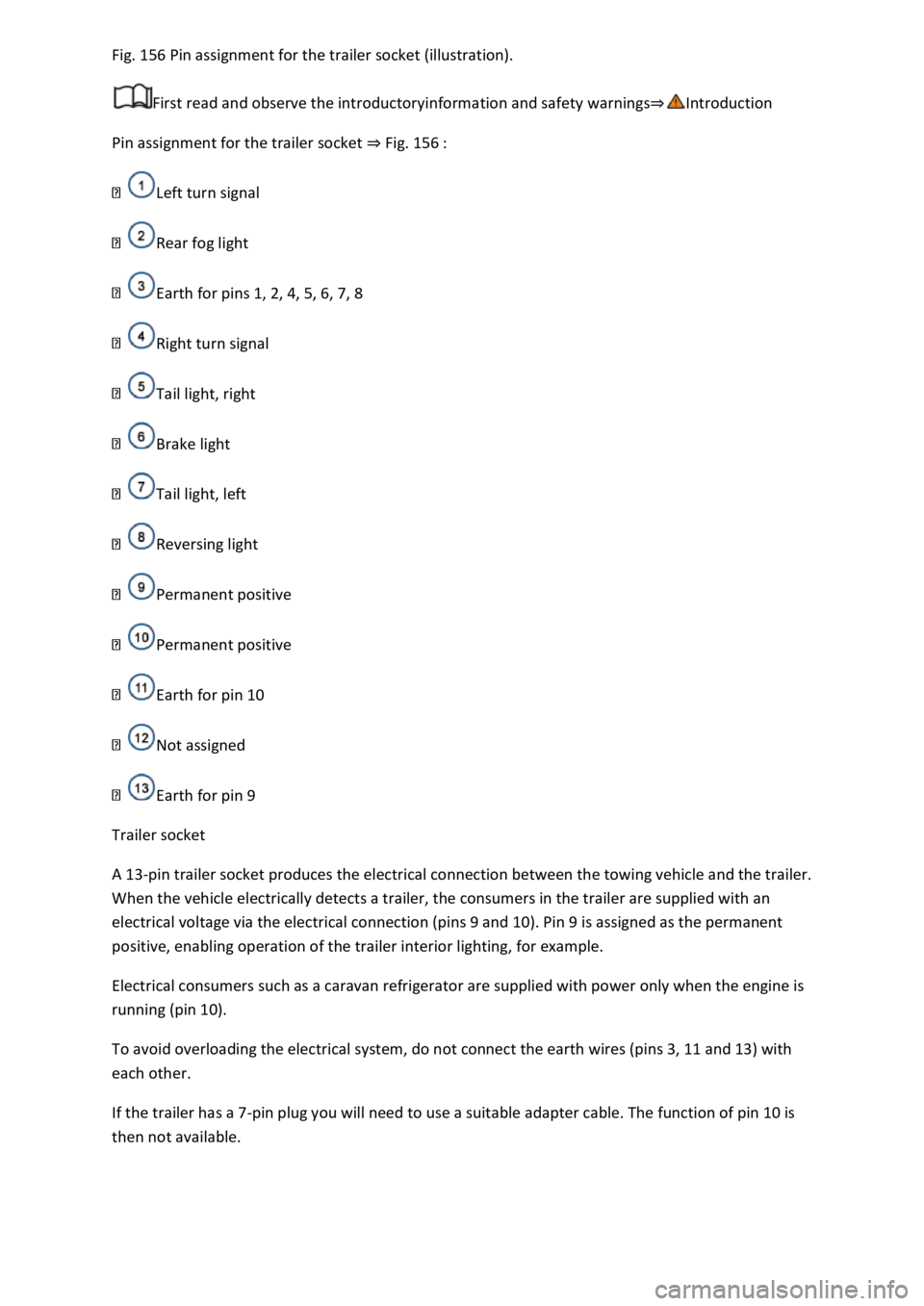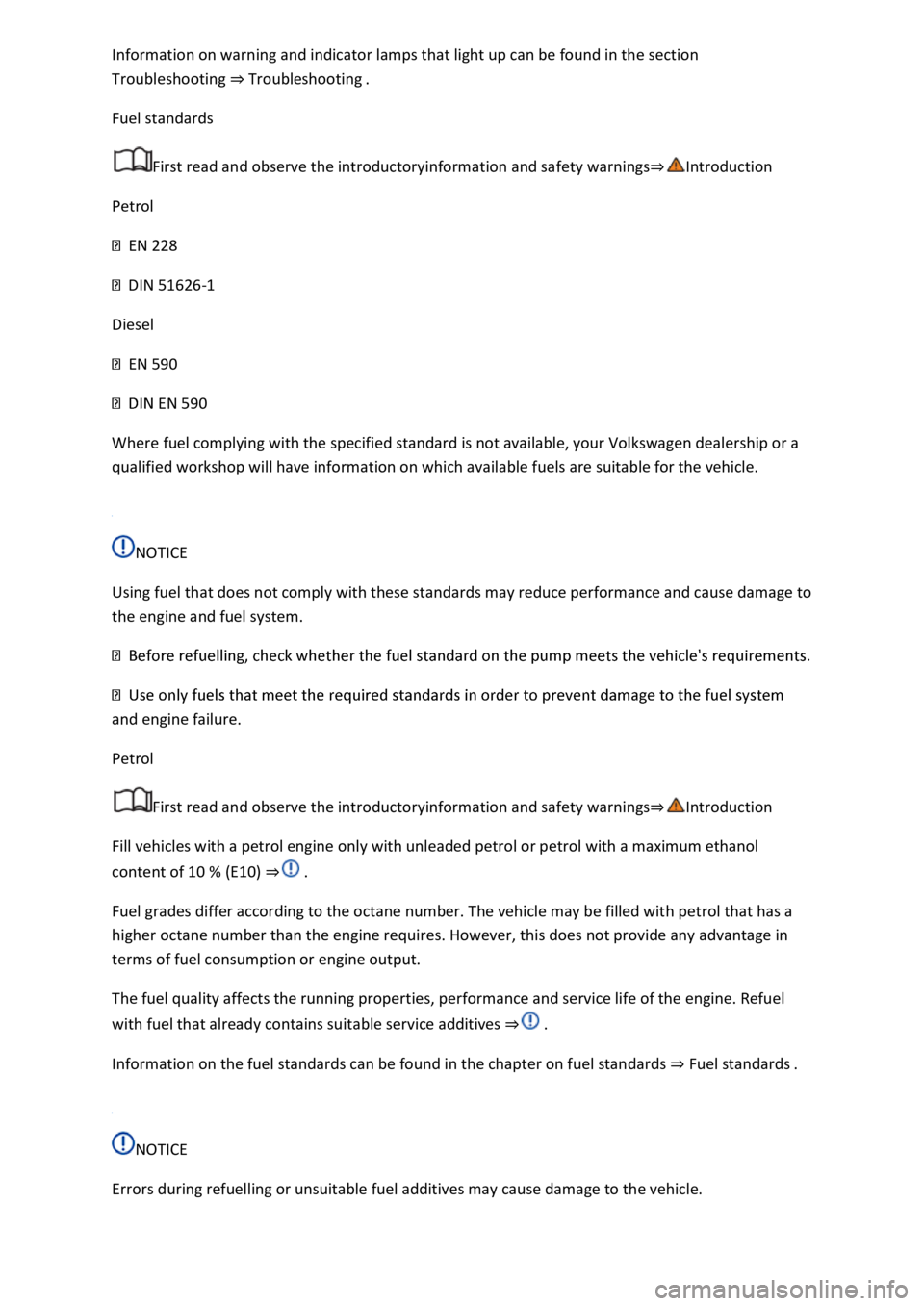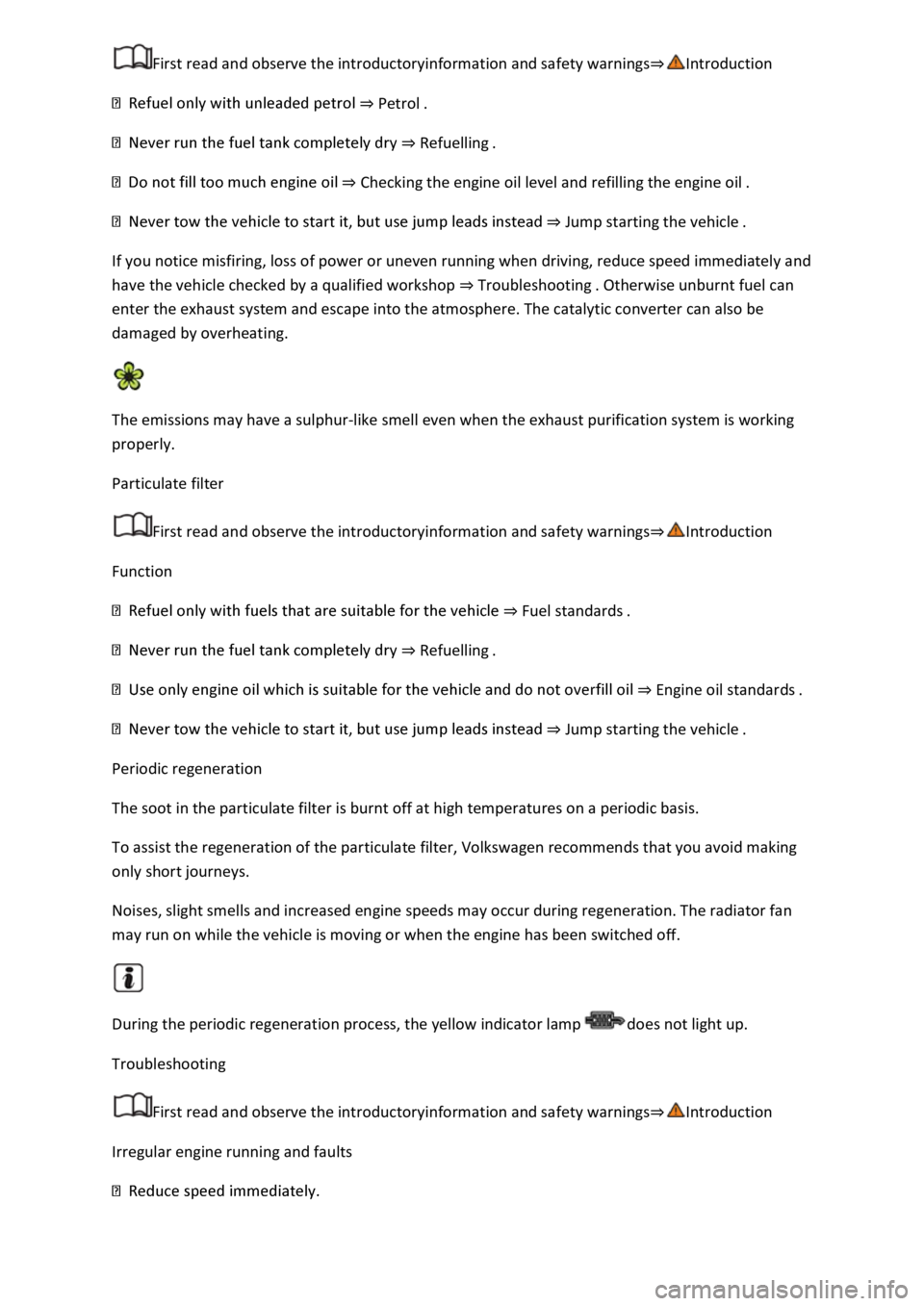Page 315 of 502

156 Pin assignment for the trailer socket (illustration).
First read and observe the introductoryinformation and safety warnings
Pin assignment for the trailer socket Fig. 156
Left turn signal
Rear fog light
Earth for pins 1, 2, 4, 5, 6, 7, 8
Right turn signal
Tail light, right
Brake light
Tail light, left
Reversing light
Permanent positive
Permanent positive
Earth for pin 10
Not assigned
Earth for pin 9
Trailer socket
A 13-pin trailer socket produces the electrical connection between the towing vehicle and the trailer.
When the vehicle electrically detects a trailer, the consumers in the trailer are supplied with an
electrical voltage via the electrical connection (pins 9 and 10). Pin 9 is assigned as the permanent
positive, enabling operation of the trailer interior lighting, for example.
Electrical consumers such as a caravan refrigerator are supplied with power only when the engine is
running (pin 10).
To avoid overloading the electrical system, do not connect the earth wires (pins 3, 11 and 13) with
each other.
If the trailer has a 7-pin plug you will need to use a suitable adapter cable. The function of pin 10 is
then not available.
Page 319 of 502
prior to downhill gradients (manual gearbox or Tiptronic mode of the
automatic gearbox) to additionally make use of engine braking. The brake system could otherwise
overheat and fail.
will change because of the
trailer load and the increased combined towing weight of the vehicle and trailer.
When driving with this combination, drive particularly carefully and slowly.
Pulling off on slopes when towing a trailer
Depending on the steepness of the uphill gradient and the total weight of the trailer and vehicle, a
vehicle towing a trailer could roll back a short distance when moving off on a hill.
When towing a trailer, pull off on slopes as follows:
once to switch off the electronic parking brake Electronic parking brake
ly.
Manual gearbox: selecting a gearor selector lever position D/SDSG
Page 323 of 502
WARNING
Filling the tank with the wrong fuel can damage the vehicle.
uels that have been approved for the vehicle.
-approved service additives in the
approved quantity.
CAUTION
Fuel may run out of a fuel canister. This could cause fire and injuries.
Fuels can pollute the environment. Collect any service fluids that escape or are spilled and dispose of
them correctly.
The tank flap cannot be opened manually. Seek expert assistance in an emergency.
Fuel types and refuelling
Introduction
This chapter contains information on the followingsubjects:
Fuel standards
Petrol
Diesel
The tank flap is located at the rear right-hand side of the vehicle.
Different engines require different fuels. There is a factory-fitted sticker in the tank flap that
indicates the required fuel type for the vehicle.
Page 324 of 502

section
Troubleshooting Troubleshooting
Fuel standards
First read and observe the introductoryinformation and safety warnings
Petrol
EN 228
DIN 51626-1
Diesel
EN 590
EN 590
Where fuel complying with the specified standard is not available, your Volkswagen dealership or a
qualified workshop will have information on which available fuels are suitable for the vehicle.
NOTICE
Using fuel that does not comply with these standards may reduce performance and cause damage to
the engine and fuel system.
and engine failure.
Petrol
First read and observe the introductoryinformation and safety warnings
Fill vehicles with a petrol engine only with unleaded petrol or petrol with a maximum ethanol
content of 10 % (E10)
Fuel grades differ according to the octane number. The vehicle may be filled with petrol that has a
higher octane number than the engine requires. However, this does not provide any advantage in
terms of fuel consumption or engine output.
The fuel quality affects the running properties, performance and service life of the engine. Refuel
with fuel that already contains suitable service additives
Information on the fuel standards can be found in the chapter on fuel standards Fuel standards
NOTICE
Errors during refuelling or unsuitable fuel additives may cause damage to the vehicle.
Page 325 of 502

requirements.
-approved service additives in the approved quantity.
emergency, you have to use petrol with an octane number lower than the recommended number,
drive at medium engine speeds and avoid high engine loading. Avoid high engine speeds and heavy
engine loads. Refuel with petrol with the correct octane number as soon as possible.
Diesel
First read and observe the introductoryinformation and safety warnings
Fill vehicles with a diesel engine only with diesel or diesel with a maximum RME fuel content of 7 %
If you use diesel with a high sulphur content, the service intervals are shorter. Information on
countries where the diesel has a high sulphur content is available from your Volkswagen dealership
or a qualified workshop.
The fuel quality affects the running properties, performance and service life of the engine. Refuel
with fuel that already contains suitable service additives
Information on the fuel standards can be found in the chapter on fuel standards Fuel standards
Winter-grade diesel fuel and filter preheater system
Winter-grade diesel fuel, which can be used at temperatures below -20
Page 326 of 502
Incorrect refuelling can lead to fire, serious injuries and vehicle damage.
requirements.
-approved service additives in the approved quantity.
At cold temperatures, louder noises may occur in the diesel engine and the exhaust gas may be
tinged blue.
Refuelling
Fig. 158 Behind the tank flap: tank cap.
First read and observe the introductoryinformation and safety warnings
See the section on technical data for information on filling capacities Fuel tank capacity
Refuelling process
button in the driver door.
it in the opening provided in the tank flap.
WARNING
Overfilling the fuel tank may cause the fuel to splash out and overflow. This can cause fires,
explosions and serious injuries.
Page 327 of 502
Introduction
This chapter contains information on the followingsubjects:
Emission control with AdBlue
Refilling AdBlue
Catalytic converter
Particulate filter
Troubleshooting
Emission control with AdBlue
Catalytic converter
Particulate filter
Information on warning and indicator lamps that light up can be found in the section
Troubleshooting Troubleshooting
WARNING
Engine emissions contain carbon monoxide which can cause people to lose consciousness. It can also
cause death.
WARNING
The components of the exhaust system become very hot. This can cause fires.
inflammable material underneath the vehicle, e.g. dry grass.
-corrosion coatings to the exhaust pipes, catalytic
converters, particulate filter or the heat shields.
Emission control with AdBlue
Page 331 of 502

Petrol
Refuelling
Checking the engine oil level and refilling the engine oil
Jump starting the vehicle
If you notice misfiring, loss of power or uneven running when driving, reduce speed immediately and
have the vehicle checked by a qualified workshop Troubleshooting
enter the exhaust system and escape into the atmosphere. The catalytic converter can also be
damaged by overheating.
The emissions may have a sulphur-like smell even when the exhaust purification system is working
properly.
Particulate filter
First read and observe the introductoryinformation and safety warnings
Function
Fuel standards
Refuelling
Engine oil sta
Jump starting the vehicle
Periodic regeneration
The soot in the particulate filter is burnt off at high temperatures on a periodic basis.
To assist the regeneration of the particulate filter, Volkswagen recommends that you avoid making
only short journeys.
Noises, slight smells and increased engine speeds may occur during regeneration. The radiator fan
may run on while the vehicle is moving or when the engine has been switched off.
During the periodic regeneration process, the yellow indicator lamp does not light up.
Troubleshooting
First read and observe the introductoryinformation and safety warnings
Irregular engine running and faults